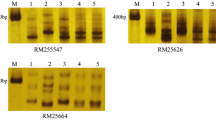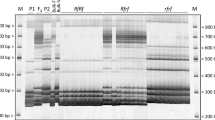Abstract
Cytoplasmic male sterility (CMS) is widely known in higher plants, the mechanism of which is believed to involve incompatibility between nuclei and cytoplasms. In rice lines with the CMS trait, fertility is restored by the aid of a nuclear-encoded gene, Rf-1, whose locus has been determined in chromosome 10. We found a particular PCR-amplified fragment, designated fL601, that specifically amplified using the DNAs from Rf-1 lines tested as templates. RFLP mapping of the fL601 locus revealed that there are two loci for the fL601, and that both are tightly linked to the Rf-1 locus. Progeny analysis also showed high frequency of their co-segregation. Southern analysis of the genomic DNA demonstrated that the Rf-1 lines shared a unique sequence in the fL601 region. These results enabled us to construct a system for specific detection of the corresponding regions. Utilizing this detection system, we established a simple PCR-mediated selection method for the Rf-1 lines, which may facilitate the breeding for hybrid rice.
Similar content being viewed by others
References
Akagi H, Sakamoto M, Shinjyo C, Shimada H, Fujimura T: A unique sequence located downstream from the rice mitochondrial atp6 may cause male sterility. Curr Genet 25: 52–58 (1994).
Allard RW: Formation and tables to facilitate the calculation of recombination values in heredity. Hilgadia 24: 235–278 (1956).
Cui X, Wise RP, Schnable PS: The rf2 nuclear restorer gene of male-sterile T-cytoplasm maize. Science 272: 1334–1336 (1996).
Dewey RE, Timothy DH, Levings III CS: Novel recombinations in the maize mitochondrial genome produce a unique transcriptional unit in the Texas male-sterile cytoplasm. Cell 44: 439–449 (1987).
Edwards K, Johnstone C, Thompson C: A simple and rapid method for the preparation of plant genome DNA for PCR analysis. Nucl Acids Res 19: 1349 (1991).
Foolad MR, Jones RA, Rodriguez RL: RAPD markers for constructing intraspecific tomato genetic maps. Plant Cell Rep 12: 293–297 (1993).
Fukuta Y, Yano M, Fukui K: Linkage analysis of rice Rf-1 gene using RFLP markers. Jpn J Breed 42(supl. 1): 164–165 (1992).
Hanson MR, Pruitt KD, Nivison HT: Male sterility loci in plant mitochondrial genomes. Oxford Surv Plant Mol Cell Biol 6: 61–85 (1989).
Innis MA, Gelfand DH: Optimization of PCRs. In: Innis MA, Gelfand DH, Sninsky JJ, White TJ (eds) PCR Protocols: A Guide toMethods andApplications, pp. 3–12, Academic Press, San Diego, CA (1990).
Iwabuchi M, Kyouzuka J, Shimamoto K: Processing followed by complete editing of an altered mitochondrial atp6 RNA restores fertility of cytoplasmic male sterile rice. EMBO J 12: 1437–1446 (1993).
Kadowaki K, Suzuki T, Kazama S: A chimeric gene containing the 5′ portion of atp6 is associated with cytoplasmic malesterility of rice. Mol Gen Genet 224: 10–16 (1990).
Katsuo K, Mizushima U: Studies on the cytoplasmic difference among rice varieties, ryza sativa L. Jpn J Breed 8: 1–5 (1958).
Kennell JC, Pring DR: Initiation and processing of atp6, T-urf13 and ORF221 transcripts from mitochondria of Tcytoplasm maize. Mol Gen Genet 216: 16–24 (1989).
Khush GS: Report of meetings to discuss chromosome numbering system in rice. Rice Genetic Newslett 7: 12–14 (1990).
Kinoshita T: Report of the committee on genes symbolization, nomenclature and linkage groups. Rice Genetic Newslett 4: 3–51 (1987).
Kishimoto N, Higo K, Higo H, Saito A: The coding sequence for rice seed catalase detects a locus different from that determined by isozyme analysis. Theor Appl Genet 87: 625–626 (1994).
Kurata N, Nagamura Y, Yamamoto K, Harushima Y, Sue N, Wu J, Antonio BA, Shomura A, Shimizu T, Lin S-Y, Inoue T, Fukuda A, Shimano T, Kuboki Y, Toyama T, Miyamoto Y, Kirihara T, Hayasaka K, Miyao A, Monna L, Zhong HS, Tamura Y, Wang Z-X, Momma T, Umehara Y, Yano M, Sasaki T, Minobe Y: A 300 kilobase interval genetic map of rice including 883 expressed sequences. Nature Genet 8: 365–372 (1994).
Laughnan JR, Gabay-Laughnan S: Cytoplasmic male sterility in maize. Annu Rev Genet 17: 27–48 (1983).
Levings III CS, Brown GG: Molecular biology of plant mitochondria. Cell 56: 171–179 (1989).
Li Z-B, Zhu Y-G: Rice male-sterile cytoplasm and fertility restoration. In: Hybrid rice. Proceedings of the International Symposium on Hybrid Rice, pp. 85–102. International Rice Research Institute, Manila, Philippines (1986).
Martin GB, Williams JGK, Tanksley SD: Rapid identification of markers linked to a Pseudomonas resistance gene in tomato by using random primers and near-isogenic lines. Proc Natl Acad Sci USA 88: 2336–2340 (1991).
McCouch SR, Tanksley SD: In: Khush GS, Toenniessen GH (eds) Rice Biotechnology. pp. 109–134. CAB International, Wallingford, UK (1991).
Michelmore RW, Paran I, Kesseli RV: Identification of makers linked to disease-resistance genes by bulked segregant analysis: rapid method to detect markers in specific genomic regions by using segregating populations. Proc Natl Acad Sci USA 88: 9828–9832 (1991).
Newton KJ: Plant mitochondrial genomes: organization, expression and variation. Annu Rev Plant Physiol Plant Mol Biol 39: 503–532 (1988).
Paran I, Michelmore RW: Development of reliable PCR-based markers linked to downy mildew resistance genes in lettuce. Theor Appl Genet 85: 985–993 (1993).
Pellan-Delourme R, Ronard M: Cytoplasmic male sterility in rapeseed (Brassica napus L.): female fertility of restored rapeseed with ‘Ogura’ and cybrid cytoplasms. Genome 30: 234–38 (1989).
Pruitt KD, Hanson MR: Transcription of the Petunia mitochondrial CMS-associated pcf locus in male sterile and fertility-restored lines. Mol Gen Genet 227: 348–355 (1991).
Rafalski JA, Tingey SV: Genetic diagnostics in plant breeding: RAPDs, microsatellites and machines. Trends Genet 9: 275–280 (1993).
Saito A, Yano M, Kishimoto N, Nakagahra M, Yoshimura A, Saito K, Kuhara S, Ukai Y, Kawase M, Nagamine T, Yoshimura S, Ideta O, Ohsawa R, Hayano Y, Iwata N, Sugiura M: Linkage map of restriction fragment length polymorphism loci in rice. Jpn J Breed 41: 665–670 (1991).
Schnable PS, Wise RP: Molecular analysis of fertility restoration in male-sterile T-cytoplasm maize. In: Abstract, of the 4th International Congress of Plant Molecular Biology, Amsterdam, No. 800 (1994).
Shinjyo C:Cytoplasmic geneticmale sterility in cultivated rice, Oryza sativa L. II. The inheritance ofmale sterility. Jpn J Genet 44: 149–156 (1969).
Shinjyo C: Genetical studies of cytoplasmic male sterility and fertility restoration in rice, Oryza sativa L. Sci Bull Coll Agric Univ Ryukyus 22: 1–51 (1975).
Tinker NA, Fortin MG, Mather DE: Random amplified polymorphic DNA and pedigree relationships in spring barley. Theor Appl Genet 85: 976–984 (1993).
Virmani SS, Shinjyo C: Current status of analysis and symbols for male-sterile cytoplasms and fertility-restoring genes. Rice Genetic Newslett 5: 9–15 (1988).
Williams JGK, Kubelik AR, Livak KJ, Rafalski JA, Tingey CV: DNA polymorphisms amplified by arbitrary primers are useful as genetic markers. Nucl Acids Res 18: 6531–6535 (1990).
Yuan LP: Increasing yield potential in rice by exploitation of heterosis. In: Virmani SS (ed) Hybrid Rice Technology: New Developments and Future Prospects, pp. 1–6. International Rice Research Institute, Manila, Philippines (1994).
Yu L-X, Nguyen HT: Genetic variation detected with RAPD markers among upland and lowland rice cultivars (Oryza sativa L.). Theor Appl Genet 87: 668–672 (1994).
Author information
Authors and Affiliations
Corresponding author
Rights and permissions
About this article
Cite this article
Ichikawa, N., Kishimoto, N., Inagaki, A. et al. A rapid PCR-aided selection of a rice line containing the Rf-1 gene which is involved in restoration of the cytoplasmic male sterility. Molecular Breeding 3, 195–202 (1997). https://doi.org/10.1023/A:1009601007175
Issue Date:
DOI: https://doi.org/10.1023/A:1009601007175




